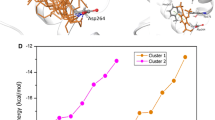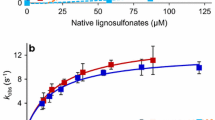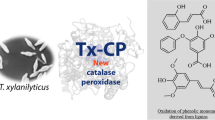Abstract
Trametes cervina lignin peroxidase (LiP) lacks a catalytic tryptophan strictly conserved in other LiP and versatile peroxidases. It contains tyrosine181 at the potential catalytic site. This protein and the well-characterized Phanerochaete chrysosporium LiP with the catalytic tryptophan171 have been chemically modified: the tryptophan-specific modification with N-bromosuccinimide sufficiently disrupted oxidation of veratryl alcohol by P. chrysosporium LiP, whereas the activity of T. cervina LiP was not affected, suggesting no catalytic tryptophan in T. cervina LiP. On the other hand, the tyrosine-specific modification with tetranitromethane did not affect the activities of P. chrysosporium LiP lacking tyrosine but inactivated T. cervina LiP due to the nitration of tyrosine181. These results strongly suggest that tyrosine181 is at the catalytic site in T. cervina LiP.
Similar content being viewed by others
Avoid common mistakes on your manuscript.
Introduction
Lignin has a complex three-dimensional architecture containing different non-phenolic units (Gellerstedt and Henriksson 2008). Its degradation is a rate-limiting step for carbon recycling in ecosystem and a central issue for industrial uses of lignocellulose (Martínez et al. 2009). High redox-potential peroxidases from white-rot basidiomycetes, lignin peroxidase (LiP; EC: 1.11.1.14) and versatile peroxidase (VP; EC: 1.11.1.16), are responsible for initial oxidative depolymerization in lignin biodegradation (Kirk and Farrell 1987; Hammel and Cullen 2008). These enzymes can oxidize high redox-potential and large molecular substrates and are of interest as industrial biocatalysts (Ruiz-Dueñas and Martínez 2009).
LiP and VP oxidize 3,4-dimethoxybenzyl (veratryl) alcohol (VA), the physiological substrate of LiP, at the tryptophan residue located at the protein surface (Fig. 1a) via a long-range electron transfer pathway to heme (Doyle et al. 1998; Gelpke et al. 2002; Pérez-Boada et al. 2005). This catalytic tryptophan is conserved in almost all LiP and VP sequences (Martínez 2002).
The P. chrysosporium LiP structure (a) and the homology molecular model of T. cervina LiP (b). Overall protein structures are shown in gray lines, involving the heme cofactors (in the center) and the selected redox active residues (Trp171 in P. chrysosporium LiP, and Trp17, Tyr181, and Trp249 in T. cervina LiP, respectively) shown in black sticks. The P. chrysosporium LiP structure was obtained from PDB entry 1LLP. The structural model of T. cervina LiP was obtained by homology modeling with the Molecular Operating Environment program (Chemical Computing Group) (Miki et al. 2010)
Recently, a new type of LiP was discovered in the white-rot basidiomycete, Trametes cervina. Although this LiP exhibits the LiP-type catalytic properties (Miki et al. 2006), it lacks the catalytic tryptophan (Miki et al. 2010). Additionally, the homology molecular model of T. cervina LiP showed that a sole Tyr181 occupies the position near the heme-propionate and is accessible to the exterior solvent (Fig. 1b), suggesting that this residue would be a catalytic site. On the other hand, the T. cervina LiP sequence contains other two tryptophans (Trp17 and Trp249) at the positions different from the catalytic tryptophan in other LiPs and VPs (Fig. 1b). Their catalytic roles would also be possible. Thus, in this study, T. cervina LiP and Phanerochaete chrysosporium LiP (the latter molecule employed as a control molecule with the catalytic Trp171) are modified by N-bromosuccinimide (NBS; tryptophan-specific modification reagent) and tetranitromethane (TNM; tyrosine-specific modification reagent), in order to determine the catalytic residue in T. cervina LiP.
Materials and methods
Peroxidases
Trametes cervina LiP and P. chrysosporium LiP were purified from the extracellular culture medium of T. cervina (WD550) and P. chrysosporium (ATCC34541), respectively, as previously described (Gold et al. 1984; Miki et al. 2006). The concentrations of peroxidases were calculated from the absorbance at 407 nm (ε407 nm 147 mM−1 cm−1) for T. cervina LiP and 408 nm (ε408 nm 133 mM−1 cm−1) for P. chrysosporium LiP.
Chemical modification
N-Bromosuccinimide (NBS)-modification mixtures containing 3 μM peroxidases, 1 mM CaCl2, and 0–50 μM NBS in 50 mM sodium acetate buffer (pH 4.0) were incubated for 30 min at 25°C. Tetranitromethane (TNM)-modification mixtures containing 3 μM peroxidases, 1 mM CaCl2, and 0–60 mM TNM in 50 mM Tris–HCl buffer (pH 7.0) were incubated for 30 min at 25°C. After 30 min, the mixtures were applied into a 3 kDa Centricon (Millipore), and excess reagents and small byproducts were removed by buffer exchange using 20 mM sodium succinate buffer (pH 4.5) containing 1 mM CaCl2. The resulting solutions containing the modified enzymes were used without further purification.
Enzyme activity assay
Oxidation activities were spectrophotometrically determined at 25°C. Initial oxidation velocities were estimated from the maximal absorbance changes at 310 nm for VA oxidation (veratrum aldehyde formation), 415 nm for ABTS oxidation (ABTS radical cation formation), 469 nm for 2,6-dimethoxyphenol oxidation (quinone dimer formation), and 550 nm for cytochrome c 2+ oxidation (cytochrome c 3+ formation). Cytochrome c 2+ was prepared by reducing cytochrome c 3+ with sodium dithionite, followed by removal of the excess dithionite with Sephadex G-25, immediately prior to use.
Results and discussion
Effects of NBS modification
T. cervina LiP and P. chrysosporium LiP were treated with NBS that selectively oxidizes tryptophan indole ring to oxindolamine. The activity for VA oxidation by P. chrysosporium LiP was decreased by the NBS pretreatment, in a linear fashion with increasing concentration of NBS used (Fig. 2); 80% of activity was lost with 50 μM NBS. This result agrees with previous studies that LiP and VP contain catalytic tryptophans using chemical modifications (Blodig et al. 1998; Johjima et al. 2002; Kamitsuji et al. 2005). VA oxidation by T. cervina LiP, however, was unaffected by NBS (Fig. 2): more than 90% of the activity remained after pretreatment with 50 μM NBS. Thus, it is suggested that tryptophans in T. cervina LiP do not have a catalytic role.
The residual activities of T. cervina LiP (closed circle) and P. chrysosporium LiP (closed triangle) pretreated with NBS. VA oxidation rates were estimated in 20 mM sodium succinate buffer, pH 3.0, containing 0.1 mM H2O2, 0.5 mM VA, and 50 nM enzyme. The residual activities compared to the activity of untreated enzymes are shown
Effects of TNM modification
T. cervina LiP and P. chrysosporium LiP were treated with TNM that selectively nitrates the aromatic ring of tyrosine and simultaneously generates nitroformate anion as a byproduct with a strong absorbance at 350 nm (Sokolovsky et al. 1967). The increase at 350 nm due to the formation of nitroformate anion, indicative of tyrosine nitration, was previously observed in the TNM treatment of plant cationic cell-wall-peroxidase with a catalytic tyrosine (Sasaki et al. 2008). Absorbance spectra of peroxidases modified by different concentrations of TNM are shown in Fig. 3. Spectra of P. chrysosporium LiP that lacks tyrosine was unaffected by TNM whereas TNM treatment of T. cervina LiP containing Tyr181 increased absorbance at 350 nm, suggesting the nitration of Tyr181.
Spectral changes of T. cervina LiP (a) and P. chrysosporium LiP (b) during TNM treatment. Spectra of peroxidases incubated for 30 min with 0, 20, 40 and 60 mM of TNM were recorded before buffer exchange. The absorbance increase at 350 nm due to generation of nitroformate anion, indicative of tyrosine nitration, is indicated by arrow in (a)
Consistent with the spectral results, VA oxidation by P. chrysosporium LiP was unaffected by TNM (Fig. 4a). More than 90% activity is observed after pretreatment with 60 mM TNM. Conversely, the activity for VA oxidation by T. cervina LiP is lowered by the TNM pretreatment, in a linear fashion with increasing concentrations of TNM used (Fig. 4a). Approx. 60% of VA oxidation activity was lost with 60 mM TNM. As shown in Fig. 4b, the loss of the activity shows a good correlation with the absorbance increase at 350 nm, suggesting that the nitration of Tyr181 causes inactivation of T. cervina LiP.
Effects of the TNM pretreatment on the catalytic activities of peroxidases. a The residual activities of T. cervina LiP (closed circle) and P. chrysosporium LiP (closed triangle) pretreated with TNM. VA oxidation rates were estimated in 20 mM sodium succinate buffer, pH 3.0, containing 0.1 mM H2O2, 0.5 mM VA, and 50 nM enzymes. The residual activities compared to the activity of untreated enzymes are shown. b The correlation between the residual activities (open diamond) and the absorbance increases at 350 nm (closed diamond), the latter indicative of Tyr181-nitration, in TNM-modified T. cervina LiP
T. cervina LiP pretreated with 60 mM TNM also had lower activities for oxidation of ABTS (37%), 2,6-dimethoxyphenol (41%), and cytochrome c2+ (50%) than untreated enzyme (Fig. 5). These results suggest that Tyr181 is involved not only in oxidation of high-redox potential non-phenolic substrate (VA) but also in oxidation of low redox-potential anionic substrate (ABTS) and a phenolic substrate (2,6-dimethoxyphenol), though other LiPs and VPs are suggested to possess different catalytic sites for these substrates (Johjima et al. 2002; Ruiz-Dueñas et al. 2009a). In addition, it is confirmed that Tyr181 also contributes to the ability to oxidize large molecule (cytochrome c), which is the requisite property for direct oxidation of polymeric lignin.
Kinetic traces for oxidation of ABTS (a), 2,6-dimethoxyphenol (b) and cytochrome c 2+(c) by T. cervina LiP pretreated with 60 mM TNM (closed circle) and unmodified enzyme (open circle). Oxidation of ABTS and 2,6-dimethoxyphenol were measured in 20 mM sodium succinate buffer, pH 3.0, containing 0.5 mM substrate, 5 nM enzyme, and 0.1 mM H2O2. Cytochrome c 2+ oxidation was measured in 20 mM sodium succinate buffer, pH 4.0, containing 14 μM cytochrome c 2+, 15 nM enzyme, and 0.1 mM H2O2
Conclusions
Several structural features contribute to the LiP-type catalytic properties for oxidation of high redox potential and large-molecular substrate such as lignin. One of the structural features is the catalytic site exposing to the exterior solvent (Ruiz-Dueñas and Martínez 2009). Although all other LiP and VP conserve the exposed catalytic tryptophan (Martínez 2002), this present study shows for the first time that Tyr181 is a catalytic site in T. cervina LiP. Though a catalytic tyrosine had never been found in other LiP and VP, different redox enzymes use this aromatic residue as a catalytic site (Stubbe and van der Donk 1998). Additionally, a VP mutant, W164Y, in which the catalytic Trp164 was substituted by tyrosine, contained a tyrosyl radical (Ruiz-Dueñas et al. 2009b) that would function as the catalytic radical like the tryptophanyl radical in native LiP and VP (Blodig et al. 1999; Pogni et al. 2006; Smith et al. 2009). These observations strongly support the idea that Tyr181 in T. cervina LiP would oxidize substrates via tyrosyl radical. Since the nature and length of the electron transfer pathway in T. cervina LiP are different from others and novel, the structure–function characterization of this enzyme is of high interest. Recently, production of recombinant T. cervina LiP by E. coli, followed by in vitro refolding, was optimized (Miki et al. 2009). Thus, further detailed mechanistic studies of this enzyme would be performed in the near future.
References
Blodig W, Doyle WA, Smith AT, Winterhalter K, Piontek K (1998) Autocatalytic formation of a hydroxy group at Cβ of Trp171 in lignin peroxidase. Biochemistry 37:8832–8838
Blodig W, Smith AT, Winterhalter K, Piontek K (1999) Evidence from spin-trapping for a transient radical on tryptophan residue 171 of lignin peroxidase. Arch Biochem Biophys 370:86–92
Doyle WA, Blodig W, Veitch NC, Piontek K, Smith AT (1998) Two substrate interaction site in lignin peroxidase revealed by site-directed mutagenesis. Biochemistry 37:15097–15105
Gellerstedt G, Henriksson G (2008) Lignins: Major sources, structure and properties In: Belgacem M, Gandini A (ed) Monomers, polymers and composites from renewable resources. Elsevier, Amsterdam, pp 201–224
Gelpke MDS, Lee J, Gold MH (2002) Lignin peroxidase oxidation of veratryl alcohol; effects of the mutants H82A, Q222A, W171A, and F267L. Biochemistry 41:3409–3506
Gold MH, Kuwahara M, Chiu AA, Glenn JK (1984) Purification and characterization of an extracellular H2O2-requiring diarylpropane oxygenase from the white rot basidiomycete, Phanerochaete chrysosporium. Arch Biochem Biophys 234:353–362
Hammel KE, Cullen D (2008) Role of fungal peroxidases in biological ligninolysis. Curr Opin Plant Biol 11:349–355
Johjima T, Wariishi H, Tanaka H (2002) Veratryl alcohol binding sites of lignin peroxidase from Phanerochaete chrysosporium. J Mol Catal B 17:49–57
Kamitsuji H, Watanabe T, Honda Y, Kuwahara M (2005) Direct oxidation of polymeric substrates by multifunctional manganese peroxidase isoenzyme from Pleurotus ostreatus without redox mediators. Biochem J 386:387–393
Kirk TK, Farrell RL (1987) Enzymatic combustion-the microbial-degradation of lignin. Annu Rev Microbiol 41:465–505
Martínez AT (2002) Molecular biology and structure–function of lignin-degrading heme peroxidases. Enzyme Microb Technol 30:425–444
Martínez AT, Ruiz-Dueñas FJ, Martínez MJ, del Río JC, Gutiérrez A (2009) Enzymatic delignification of plant cell-wall: from nature to mill. Curr Opin Biotechnol 20:348–357
Miki Y, Tanaka H, Nakamura M, Wariishi H (2006) Isolation and characterization of a novel lignin peroxidase from the white-rot basidiomycete Trametes cervina. J Fac Agr Kyushu Univ 51:99–104
Miki Y, Morales M, Ruiz-Dueñas FJ, Martínez MJ, Wariishi H, Martínez AT (2009) Escherichia coli expression and in vitro activation of a unique ligninolytic peroxidase that has a catalytic tyrosine residue. Protein Expr Purif 68:208–214
Miki Y, Ichinose H, Wariishi H (2010) Molecular characterization of lignin peroxidase from the white-rot basidiomycete Trametes cervina: a novel fungal peroxidase. FEMS Microb Lett 304:39–46
Pérez-Boada M, Ruiz-Dueñas FJ, Pogni R, Basosi R, Choinowski T, Martínez MJ, Piontek K, Martínez AT (2005) Versatile peroxidase oxidation of high redox potential aromatic compounds: site-directed mutagenesis, spectroscopic and crystallographic investigation of three long range electron transfer pathways. J Mol Biol 354:385–402
Pogni R, Baratto MC, Teutloff C, Giansanti S, Ruiz-Dueñas FJ, Choinowski T, Piontek K, Martínez AT, Lendzian F, Basosi R (2006) A tryptophan neutral radical in the oxidized state of versatile peroxidase from Pleurotus eryngii: a combined multifrequency EPR and density functional theory study. J Biol Chem 281:9517–9526
Ruiz-Dueñas FJ, Martínez AT (2009) Microbial degradation of lignin: how a bulky recalcitrant polymer is efficiently recycled in nature and how we can take advantage of this. Microb Biotechnol 2:164–177
Ruiz-Dueñas FJ, Morales M, García E, Miki Y, Martínez MJ, Martínez AT (2009a) Substrate oxidation sites in versatile peroxidase and other basidiomycete peroxidases. J Exp Bot 60:441–452
Ruiz-Dueñas FJ, Pogni R, Morales M, Giansanti S, Mate MJ, Romero A, Martínez MJ, Basosi R, Martínez AT (2009b) Protein radicals in fungal versatile peroxidase: catalytic tryptophan radical in both compound I and compound II and studies on W164Y, W164H and W164S variants. J Biol Chem 284:7986–7994
Sasaki S, Nonaka D, Wariishi H, Tsutsumi Y, Kondo R (2008) Role of Tyr residues on the protein surface of cationic cell-wall-peroxidase (CWPO-C) from poplar: potential oxidation sites for oxidative polymerization of lignin. Phytochemistry 69:348–355
Smith AT, Doyle WA, Dorlet P, Ivancich A (2009) Spectroscopic evidence for an engineered, catalytically active Trp radical that creates the unique reactivity of lignin peroxidase. Proc Natl Acad Sci USA 106:16084–16089
Sokolovsky M, Riordan JF, Vallee BL (1967) Tetranitromethane. a regent for the nitration of tyrosyl residues in proteins. Biochemistry 5:3582–3589
Stubbe J, van der Donk WA (1998) Protein radicals in enzyme catalysis. Chem Rev 98:705–762
Author information
Authors and Affiliations
Corresponding author
Rights and permissions
About this article
Cite this article
Miki, Y., Ichinose, H. & Wariishi, H. Determination of a catalytic tyrosine in Trametes cervina lignin peroxidase with chemical modification techniques. Biotechnol Lett 33, 1423–1427 (2011). https://doi.org/10.1007/s10529-011-0571-2
Received:
Accepted:
Published:
Issue Date:
DOI: https://doi.org/10.1007/s10529-011-0571-2









